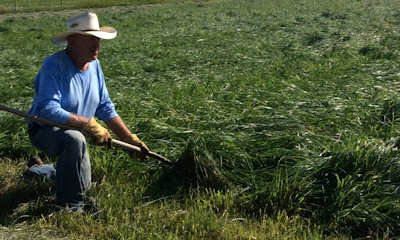October 1, 2015

Editor's Note: This is the first of a two-parts on how a Wyoming producer "makes hay" in the specialty forage market.
“Hay is for horses,” the old saying goes.
Make it: “Great hay is for horses.”
And farmers trying to grow the best alfalfa, grass and mixed hays possible pay close attention to their noses, eyes and fingers.
Just ask Wyoming producers like Gerry Danko, Powell; David, Teri and Kellie Hinman, Wheatland; Daryl Tiltrum, also of Wheatland; Harlan Fegler, Arapahoe; and the owners of Anderson Livestock, Pine Bluffs.

NEARING PAYDAY: Gerry Danko kneels by a windrow of premium hay on his Powell, Wyo., farm.
They are among the growers who have consistently placed high at the World Forage Analysis Superbowl in Madison, Wis., held annually in late September and early October.
“You have to stick your nose in the hay to help determine how good it is,” says Danko. “The hay shouldn’t tickle your nose and make you sneeze. There shouldn’t be any whiffs of mold. It just has to smell good. When that happens, you know you’re horse is going to think it smells good, too, and you know that the hay is going to be good for your horse.”
Danko and a number of other Wyoming hay producers have found a niche market in growing top quality hay for horses, dairy cows and dairy goats as well as certified weed-free hay for use on national forests (any hay that doesn’t meet premium standards makes great feed for beef cattle).
Rising reputation
Wyoming’s reputation for growing excellent alfalfa and grass hays continues to increase regionally and nationally. Among the factors: cool nights, high elevation, low humidity and lack of rain. Irrigation helps farmers precisely control the amount of water applied, a double bonus considering the lack of natural precipitation. Beyond this is active marketing by the Wyoming Business Council’s Agribusiness Division as well as word-of-mouth based on the reputation of the hay and its growers.
“People started coming to us for nice horse hay because good horse hay is not always available,” Danko says. “People who make horses part of their way of life want good hay year-round, and that became a niche market for us.”
Danko’s favorite hay (he says the horses agree) is a mix of brome and orchard grasses along with alfalfa to boost protein levels.
“As smart as you can be, you can still make poor hay, but you know it and don’t sell it as premium hay. What we watch for is trying not to screw up good hay.”
Beyond his nose, Danko carefully monitors how the hay looks and feels during the growing season.
“Hay should be cut before it becomes too coarse, and it should have a very nice green color,” he says. “As brome and orchard grasses start to mature in the field, they become susceptible to molds, and overly mature grass is an invitation to producing dusty hay. It starts to get a brown tinge to it as soon as you cut it.”
Danko says that he tries to get three cuttings out of his mixed grass hay, which is unusual in the area. Most farmers growing hay strictly for beef cattle typically opt for two cuts to cut down on production costs and boost production since the grass is more mature.
However, Danko says, feed value typically goes down with two cuts while mold and dust susceptibility rises.
You May Also Like




